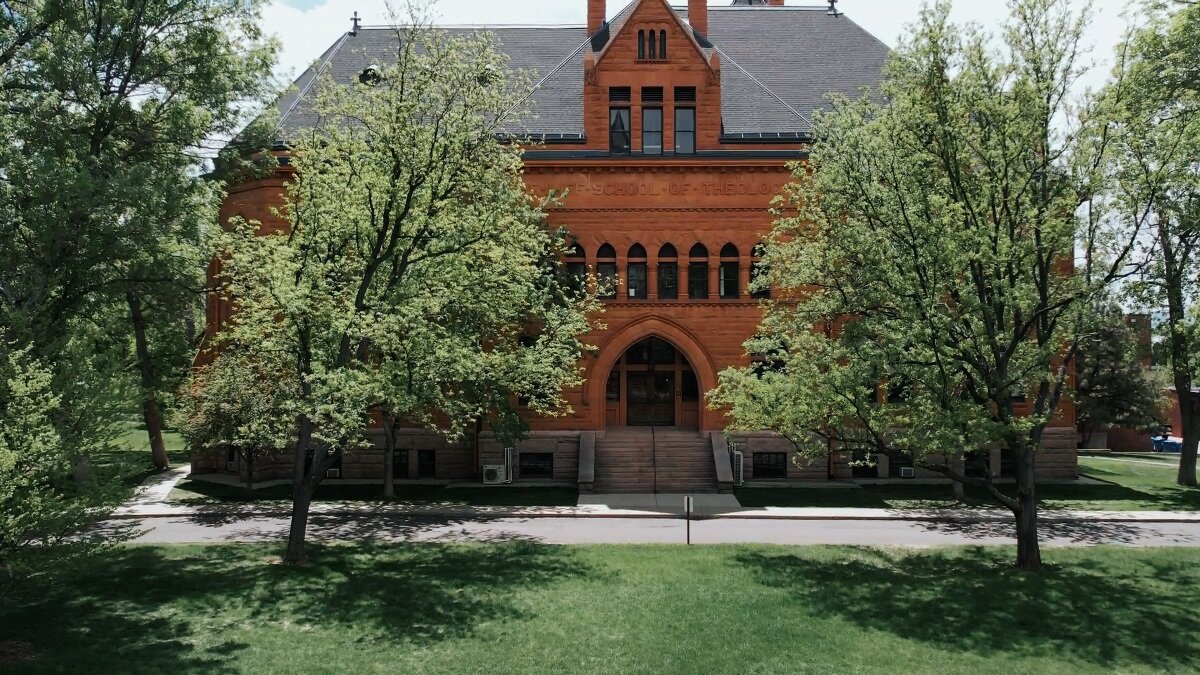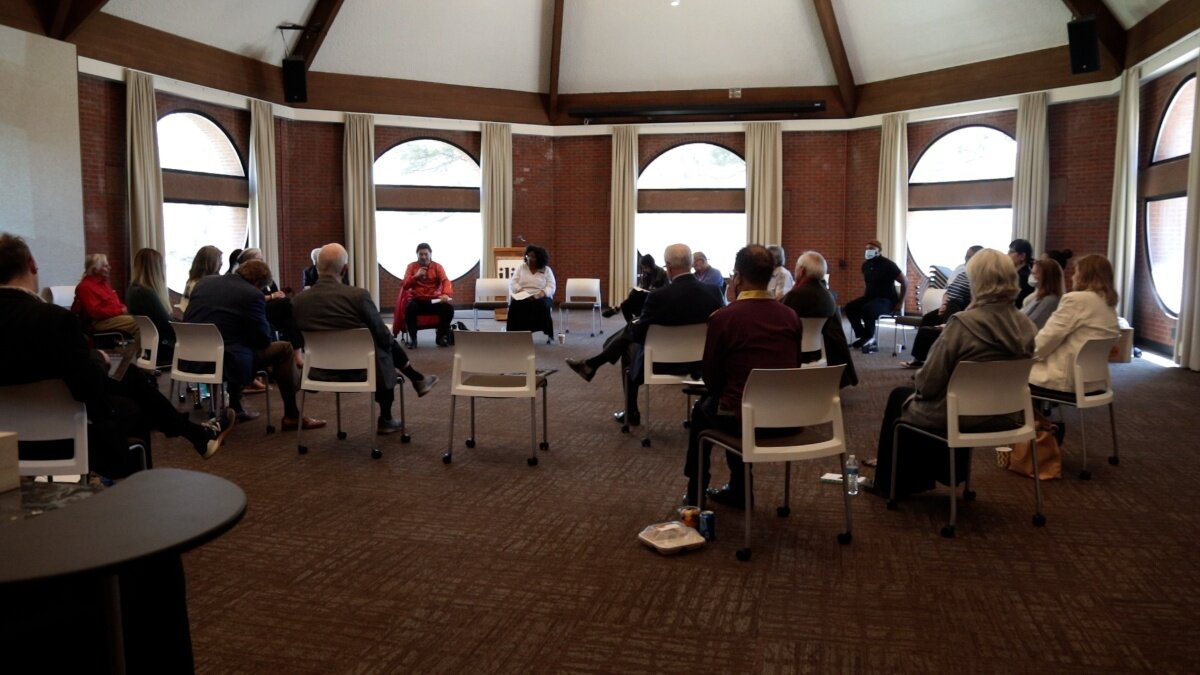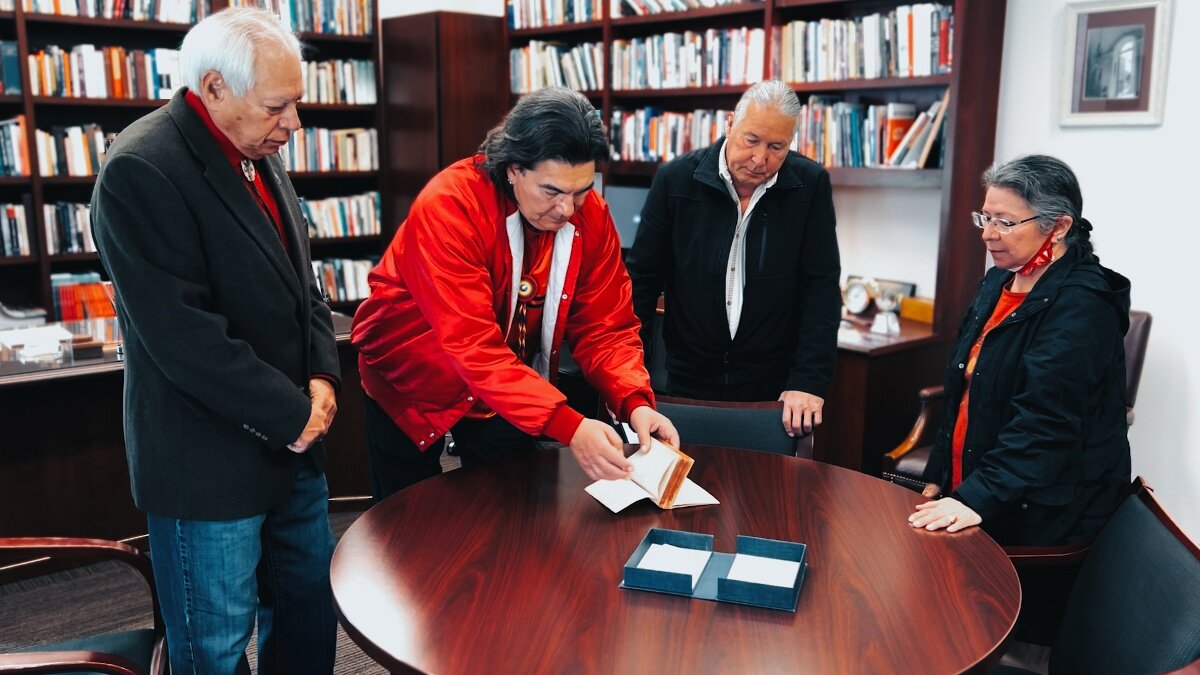A new chapter: Coming to terms with a gruesome legacy

DENVER — A book once revered by white people and put on proud display at a Denver seminary later became an object of such shame and bitterness that it has taken its custodians decades to come to terms with it.
The book is a history of Christianity in Latin, published in 1752. At some point, the volume acquired a grotesque cover — the flayed, tanned skin of a murdered Native American.
For 129 years, the book has been kept at the Iliff School of Theology, affiliated with the United Methodist Church, a school that describes itself as being “recognized nationally and internationally for its emphasis on peace, justice, and ethics.” Its alumni include ministers, chaplains, scholars and political leaders across the country.
In 1893, a Methodist minister presented the book as a gift to the then-new school on the University of Denver campus. For decades, the book was displayed in a glass case at the entrance to Iliff’s library.
"It's deeply ironic that they would cover that book of Christian history with human skin taken from a murder victim, … an Indian,” George “Tink” Tinker, professor emeritus of American Indian cultures at Iliff and a citizen of the Osage Nation (Wazhazhe), told Rocky Mountain PBS.
Tinker has written extensively about the book, its origins and its significance. He said it was long regarded as "a trophy, as a sacred relic of triumph over Indians."
[Key documents: Explore newspaper articles, correspondence and records on the book from the school’s archives]
Nearly 50 years ago, facing pressure from students and finally seeing the book as an embarrassment rather than a treasure, Iliff officials had the cover of human skin removed and took the book off display. School leaders at the time wanted to silence the controversy, and swore to secrecy those with knowledge of the situation.
Decades later, Iliff began to see things differently. “It was time for us to tell the truth about this book,” said Thomas Wolfe, the current school president and CEO.
Now the book and its gruesome history have spawned a gathering of cultures to share perspectives and search for a path forward. It’s a journey that participants hope will lead to accountability and understanding.
Across the country, other colleges as well as museums and federal agencies are coming to terms with Native American remains and cultural artifacts they have long possessed, recently including Yale University, the University of California-Berkeley and the University of Kansas.
A 1990 law, the Native American Graves Protection and Repatriation Act (NAGPRA), lays out a process for the return of Native American remains and objects taken from tribal lands. The National Park Service estimates that the remains of at least 108,000 native people are in the hands of non-tribal institutions, including colleges and museums.
The Denver Museum of Nature & Science, which has a large collection of Native American artifacts in its anthropology collections, says it “has returned numerous cultural items through NAGPRA. … The museum has consulted on all known Native American human remains in its collections and only curates human remains for which informed consent has been given by the individual or her/his family, kin, or community.”
A murder and a defiled body
Different stories about the Iliff book cover’s origins have been told over the centuries. According to Tinker and Loring Abeyta, an Iliff adjunct lecturer who is Tinker’s wife, the cover came from the defiled body of a member of the Lenape people, original inhabitants of parts of what is now the northeast United States.
In 1779, they wrote recently, a white farmer who was occupying Lenape land in western Virginia killed two native men “for the crime of walking across what he considered his own property.” They refute early accounts that described the killing as the result of a heroic fight with a “warrior.”
One of the Lenape men “had his skin flayed so that it could be some sort of a trophy or a treasure,” Abeyta told Rocky Mountain PBS. “And then … there was some decision made that it was a great idea to bind the book in the skin of this Lenape victim.”
Held by the farmer’s family, the book “evidently was enough of a treasure that it was … shown around and bragged about,” she said.
Eventually the book wound up in the hands of a Methodist minister, R.M. Barns, who had moved to Colorado. Barns donated the book to Iliff in 1893, then in its second year.
For the next eight decades, Iliff had the book on display in a glass case. A 1934 article about the book in the Rocky Mountain News described its cover as “finer than the finest vellum" and praised the skin’s “smoothness and texture equal [to] the finest parchment.” The article called the volume “one of the most treasured relics in the library of the Iliff School of Theology” and a “priceless vestment for the teachings of brotherly love.”
In 1974, the book drew another kind of attention from some Iliff students, who protested the display. They also reached out to local American Indian Movement representatives.

Jerry Campbell, then an assistant librarian at Iliff and later president of Claremont School of Theology and Claremont-Lincoln University, said he was given the task of severing the cover from the book with a blade so the skin could be turned over to the American Indian Movement (AIM) for burial on native land.
“I remember thinking, ‘Good grief, this is the skin of a human being,’” Campbell told United Methodist News in an October 2020 article. “I just remember thinking this is a terrible thing to have here and be kind of celebrating it.”
At the time, Iliff leaders decided to maintain silence about the book and its cover, asking AIM and others with knowledge of the situation to sign a non-disclosure agreement “in order to protect Iliff in terms of its fundraising potential,” Tinker said.
“That’s immoral and unethical,” Tinker said of the secrecy. “… Christians have two words for it that we don’t have in any Indian language. It was evil, and it was sinful.”
The school has stored the coverless book out of public view ever since.
‘Nobody will talk to you about this’
Tinker said he learned of the book in 1986, shortly after joining the Iliff faculty.
"One of my colleagues pulled me aside, and said, 'Nobody will talk to you about this, but you need to know that this happened at Iliff’,” he said.
Tinker said he "almost left" Iliff after hearing about the book, "because it is so disturbing to an American Indian."
Instead of leaving, he said, "I waited until everybody was in church on Sunday, ... and I went back in the building, and I smudged every nook and cranny I could."
The school’s policy of secrecy about the book and its sordid past changed after Wolfe, a United Methodist pastor and elder, arrived as Iliff president in 2013.
Wolfe said he had learned about the book years before coming to Iliff, hearing talk about it at a 1996 United Methodist conference in Denver.
“Just the idea of a book covered with the skin of a Native American person was profoundly disturbing,” Wolfe told Rocky Mountain PBS. "You don’t have to be affiliated with the school to feel that. It’s part of a long history of violation of native peoples in this country.”
He said the book represents “not just one institution’s lack of understanding but [also] the whole nature of Christian domination that misplaced and murdered millions of native people.”
The cover may be gone, Tinker said, but that “doesn’t remove entirely the spirit of that Lenape murder victim from the book itself. Something needs to happen to that book. But Iliff shouldn’t do anything without talking to Lenape people.”
Tinker also advocated that Iliff look beyond the disposition of the book itself. “I really wanted to change the behavior of my white relatives,” he said.
‘Making things right for our ancestor’
And so Tinker and Wolfe asked Lenape elders to come to Denver and offer guidance. That led to two days of meetings in April that Rocky Mountain PBS was invited to observe. The elders also examined the book.
“Our big question is, what do we do with the book?” Wolfe said, “and the understanding was, we are preparing ourselves to be guided.”

Among those on hand for the meetings was Curtis Zunigha, co-founder of the Lenape Center, an arts and culture organization, and cultural director and a former chief of the Delaware Tribe. (Delaware is another name for the Lenape people.)
“It’s important that the Iliff School at least listen to us and try to take steps in a new and better direction,” Zunigha told Rocky Mountain PBS. He said Iliff must recognize that by accepting the book in 1893 and knowing its origins, “they became complicit in the colonial domination and the racism” against natives.
Zunigha said that the spiritual force of the murdered Lenape man whose skin covered Iliff’s book remains centuries after his death.
“The Lenape way of life was one of understanding that not only do we as humans have a living spirit, but that all of creation has a living spirit,” Zunigha said. “… The spirit endures beyond just the physical life.”
Another elder at the meetings was Patricia Noah, who said she reacted with "disgust and sadness and heartache" when Zunigha told her about the Iliff book.
"I think that [murdered] man's spirit got caught between this physical world and the spiritual world," she said. "He couldn't get to the spiritual world because part of [him] was put on that book. Part of his spirit stayed there and was stuck there."
[Related: Curtis Zunigha and Patricia Noah talk about death practices and beliefs among the Lenape people]
Out of their Denver meetings, the Lenape delegation presented a “statement of guidance and direction” calling on Iliff to take a number of steps. Those steps include creating a display or memorial about the book, establishing “an Interpretive Center to educate Indians and non-Indians [on] the truths of American history as it pertains to the Indigenous nations,” funding an endowed professorship “filled by an American Indian activist scholar,” and enhancing curriculum.
“At such time as it is requested by the Lenape, the Elders will take possession of the book,” the statement says.

Iliff leaders formally accepted the Lenape delegation’s recommendations and offered their own document outlining “active steps” the school will take to meet them. Another in-person meeting with the Lenape elders is scheduled for April 2023 to review progress on the recommendations.
“The Board of Trustees and the leadership of Iliff School of Theology and their successors support and commit to a permanent relationship with the Lenape Elders and their successors toward building a new history and relationship in full recognition of Iliff’s history of possession of the book of Christian history covered in the skin of a Lenape man,” the Iliff document says.
For now, the book will stay at Iliff. Said Zunigha: “The sense of response and commitment from Iliff will … inform and frame our attitude about taking possession of this book and making things right by that ancestor.”
Until the book is turned over, it “will remain in a secure and respectful place within the President’s Office,” the Iliff response document said.
It’s clear that the process discussed in the talks will not be concluded overnight, and will need to be carried forward by future Iliff administrations.
“This is going to be a commitment that this generation is making for this institution going forward in time,” Wolfe said.
“Changing a worldview … happens over a lifetime, but it doesn’t happen until people start thinking a different way,” Tinker said. “That’s what I want, for Iliff and for all of my Euro-Christian relatives.”
Alexis Kikoen is the senior producer at Rocky Mountain PBS. You can reach her at alexiskikoen@rmpbs.org. Jeremy Moore is the senior multimedia journalist with Rocky Mountain PBS. You can email him at jeremymoore@rmpbs.org.
Mark Harden is an editor and reporter who has worked with Rocky Mountain PBS, The Denver Post, The Colorado Sun, The Denver Business Journal and more. You can reach him here.
Illustrations for this episode of Colorado Voices were created by Danielle SeeWalker.